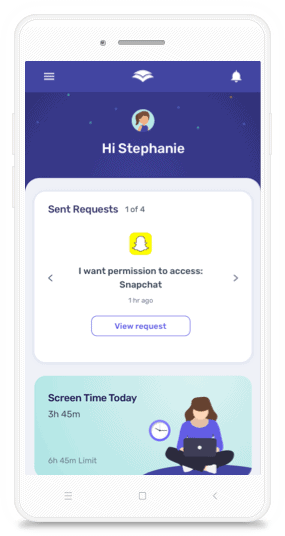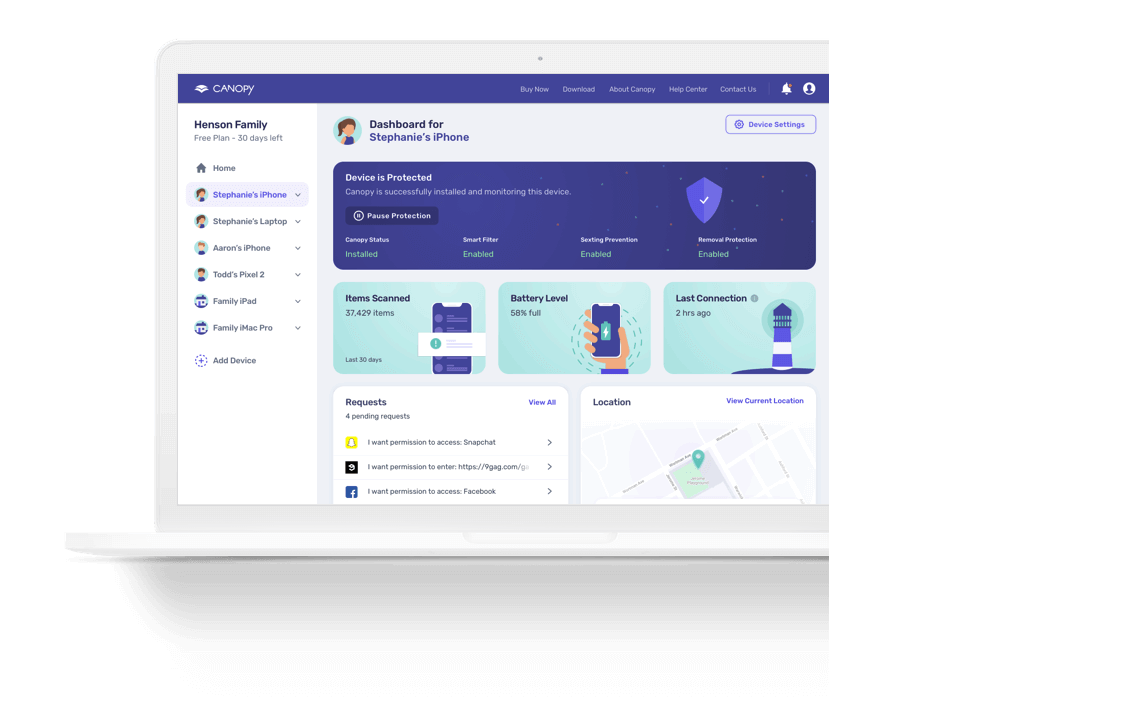Instagram has about a billion monthly active users and over 500 million logging on each day. In 2018, 72% of teenagers used the platform, and as of October 2020, it was the third most popular social network with teens. With millions of kids posting and connecting digitally, you might be asking, “are there Instagram parental controls?”
What is Instagram?
“Instagram is a free photo and video sharing app available on iPhone and Android. People can upload photos or videos to our service and share them with their followers or with a select group of friends.”
Users can share photos or videos, some that are on their profile forever unless intentionally removed, and some that are there only 24 hours or shorter. Photo and video captions can be up to 2,200 characters and include up to 30 hashtags. Profiles can be public or private, and if a profile is public, whatever is posted is also public. Users can comment on other photos and “like” or share them, as well.
Each user also has a feed when they open the app or log on through the website that is populated by the posts and stories from those who they follow, including both people and businesses. Businesses have Instagram accounts and use them for marketing, and they can sponsor content to show up in the feed of other users whose data indicates potential interest.
What’s it rated?
In the App Store, it’s rated 12+ (age 12 and older), and the rating on Google Play is “teen” (age 13 and up). Instagram requires users to be at least age 13, but according to a 2020 Pew Research survey, about 11% of parents with kids ages 9-11 know their kids are on the platform. As with most social media platforms and apps, there’s no way to verify the age of someone.
There are no Instagram parental controls available…but there are privacy settings the user can select.
No, there are technically no Instagram parental controls available because there is no way to actually control the settings. Parents can take a number of steps to help their child stay safe on Instagram, but the user of the account (the child) can change them at any time while using the app. Talking through these safety precautions in advance is always helpful.
Things you can do to keep your child safer without official Instagram parental controls:
When an Instagram account is created, there are several defaults that make an account public, sharable, and findable. To make an account more private, log onto Instagram and complete the following steps:
- Go to the user’s profile*
- Tap the three lines in the upper right corner
- Select Settings
- Choose Privacy
- Make it a Private Account
*If you are doing this through a web browser on a computer, simply click on the user’s profile picture in the upper right corner to select Settings.

If an account is public, anyone can see everything. When it is private, someone must request permission to follow and see the users posts and activity. Below the private/public account choice, you can walk through choices to make comments, tags, mentions, stories, activity, and messaging more or less private.
It is particularly helpful to manage messaging because that its how strangers may be able to contact your child. It is possible for only approved followers to message a user, and that limits the possibility of someone who your child does not know contacting them. To manage message settings complete the following steps, also in the Privacy section of Settings. Make sure the user has the latest version of Instagram to ensure that all these choices are available.
To manage who can send you message requests on Instagram:
- Go to the user’s profile*
- Tap the three lines in the upper right corner
- Select Settings
- Choose Privacy
- Tap Messages
*If you are doing this through a web browser on a computer, simply click on the user’s profile picture in the upper right corner to select Settings.
From there, according to the Instagram website, “Choose whether message requests from potential connections or other people go to your Chats list (inbox), Message Requests folder, or whether to receive them at all. Note that you’ll need to accept message requests in your Message Requests folder before they appear in your Chats list. Messages from people you follow on Instagram will appear in your Chats list.”
There are also choices that you can make about Group Chats, as well. Either everyone on Instagram or only people a user follows on Instagram can add them to these, depending on what you select.
Users can unfollow and block others if they want to remove content from their feed or prevent someone from interacting with them at all on the social media platform. They can also remove comments, if they are a problem, and are encouraged to report bullying and harassment to Instagram if it happens.
It’s not technically part of Instagram parental controls, but you can set the app to help your child monitor the amount of time they spend on it.
With Canopy, you can choose to cut off Internet access to social media apps, have your child use them through the web browser to make sure that they are filtered and never see an explicit image, and choose settings through Apple parental control and Android parental control. However, if you are wanting your child to make wiser choices with a slight nudge instead of making the choice for them, Instagram has a section in Settings to help.
- Tap on Your Activity
- Go to the Time tab
- Select Set Daily Reminder
- Choose how long you can be on Instagram before receiving a reminder about your own activity
If you want to help your child choose to spend less time on the app, this is a good reminder for them. However, it does not force someone to close the app.
Instagram’s Community Guidelines and Standards
Similar to most social media platforms, Instagram has a set of rules and regulations to make it “an authentic and safe place for inspiration and expression.” Users may only post only their own photos and videos, must follow the law, must respect others on Instagram, not spam people, and not post nudity.
Instagram users must follow Community Standards set by Facebook, their parent company. These standards include rules and regulations about violence and criminal behavior, safety, objectionable content, integrity and authenticity, respecting intellectual property, and content-related requests and decisions.
They have a specific section that talks about how “photos and videos that are appropriate for a diverse audience” includes not allowing nudity. “This includes photos, videos, and some digitally-created content that show sexual intercourse, genitals, and close-ups of fully-nude buttocks. It also includes some photos of female nipples, but photos of post-mastectomy scarring and women actively breastfeeding are allowed. Nudity in photos of paintings and sculptures is OK, too.” They will remove photos that show “nude or partially-nude children”
A parent’s guide to Instagram
There may be no Instagram parental controls, but they do a good job at helping parents understand the platform, talk with their kids about using it, and understand it. They provide a downloadable document called Know How to Talk with Your Teen About Instagram: a Parent’s Guide. It includes an in-depth look at the app and stories of how parents and teens can work together to keep kids safe.
Concerns associated Instagram
Despite the safety precautions that you can take to protect your child, there are still some concerns with allowing children to participate on this platform.
- Cyberbullying is all too common on Instagram.
- Teens are pressured to manage their image in ways that adults who grew up without social media never experienced.
- The rise in depression and suicide among teens coincides with the rise of social media use by those in these same age groups.
A Forbes article goes on to explain how Instagram, specifically, how neuroscience proves Instagram is bad for teen girls. It heightens the temptation for young women to compare themselves to others, uses data from functional MRIs to show that the number of “likes” a post receives affect our view of it, the amount of hours spent on it “shifts how young women view social approval,” and how an app that focuses on appearance and has “filters, makeup, lighting, angles and posing mean that the images consistently fed to young girls are not based in reality.”
The good news of Instagram
While it is important to understand the risks of engaging in social media in order to best prepare your children to engage in the online world as responsible digital citizens, there are also many benefits and good things that come from engaging in Instagram.
According to The National Center for Biotechnology Information, when adolescents use social media platforms, like Instagram, they have “feelings of greater connection to friends and interactions with more diverse groups of people who can provide support” and “higher internet use has been associated with positive social well-being, higher use of communication tools, and increased face-to-face conversations and social contacts in college students.”
Instagram can increase connection, communication, support, networking, self-expression, and much more. Young people report feeling like they have a voice and can express themselves freely. Like adults, they are able to keep up with friends, share exciting news, and laugh at funny memes. Much of Instagram is truly for fun and can help kids, especially during the pandemic, connect with each other.
Is the platform safe and wise for your child to use without Instagram parental control?
You know your child better than anyone. You know what it’s like to talk through various app settings and parental controls. And you know if they are ready to engage in it without Instagram parental control available. As with all other messaging apps and social media platforms, it’s not only about the content that your child can access but also their maturity and ability to navigate it wisely.
Together, you can discuss the realities of Instagram, how to be a responsible digital citizen, and if your child is ready to participate in the platform.
How Canopy works with Instagram
Canopy can filter out pornographic content on the web browser version of Instagram. If your child is using Instagram, you can remove permission to use the app in the App Management tool of Canopy, making it only possible for the system to be accessed from a web browser. If you would prefer that your child does not use Instagram, then you can not only remove permission to use the app but also block the URL from the Website Management tool. Canopy helps you protect those you love most. Try it today, for free!
More parental control resources
- What is Parental Control?
- 7 Best Porn Blockers
- How to Set Up Netflix Parental Controls
- How to Set Up iOS Parental Control (Apple)
- How to Set Up Android Parental Control
- Is Discord Parental Control Possible?
- Is Snapchat Parental Control Possible?
- How to Set Up Hulu Parental Control
- What About TikTok Parental Control?
- How to Set Up Apple TV Parental Controls
- Are There Instagram Parental Controls?
- How to Set Up Peacock Parental Controls
- How to Set Up Amazon Prime Video Parental Control
- How to Set Up Disney Plus Parental Control
- How to Set Up CBS All Access Parental Controls
- How to Set Up Windows 10 Parental Control
- How to Create a Gmail Account for a Child






